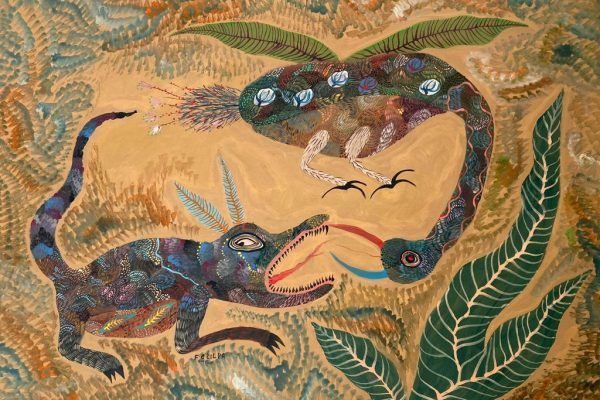Chico da Silva e a Escola do Pirambú
Pavilion 1 and Auditorium – Pinacoteca do Ceará
Fortaleza, CE
July, 2023
CURRENT EXHIBITIONS
Cores que cantam, dragões que se devoram: O universo de Chico da Silva
Museu da Imagem e do Som Chico Albuquerque
Fortaleza, CE
September 2023
Chico da Silva
A Brazilian artist of Indigenous descent, Francisco da Silva, known as Chico da Silva or simply “Chico”, was painting fantastical universes on the walls of fishermen’s houses in the 1940s when the Swiss art critic Jean-Pierre Chabloz first encountered his visionary work. An émigré from war-torn Europe, Chabloz hailed Chico’s paintings as a pure manifestation of Brazilian visual art, which he believed had been tainted by the influence of European neoclassicism. His outsized influence, however, has left a complicated legacy for Chico’s oeuvre that is only being reckoned with today.
Chabloz spent months seeking a first meeting with Chico before the artist agreed, fearing legal repercussions for his murals. In words that reveal a clearly racialized paternalism, Chabloz described Chico as an “authentic Aboriginal with copper skin from the upper Amazon” and a “sympathetic nomadic, gloriously primitive, divinely illiterate and, above all, a wonderful artist who, until then, lacked nothing but a favorable opportunity to reveal his extraordinary gifts”.The critic viewed himself as “the instrument of the revelation” of Chico’s vivid, hallucinatory visions, rooted in Amazonian cosmologies and ranging from folkloric and spiritual figures to plants and anthropomorphic animals. Chabloz provided his protégé with canvas and painting materials, replacing the charcoal, chalk, fruits and other organic substances the artist had previously used to produce his pigments.
Chico was born in 1910 to an Indigenous Peruvian father and a mother from Ceará in northeastern Brazil. His childhood was spent in the Amazon rainforest before the family relocated to Quixadá, where his father died after being bitten by a rattlesnake. Chico eventually settled in the slums of coastal Fortaleza, where Chabloz found his murals.
Chabloz catapulted Chico to fame in 1952 with an article entitled “A Brazilian Indian reinvents painting” in the French artistic journal Cahiers d’Art, which championed the authentic “naïve” spirit of the self-taught Indigenous artist. He organized exhibitions of Chico’s work in prestigious museums in Rio de Janeiro, São Paulo, Paris and in several Swiss cities.
But while Chabloz played an essential role in promoting Chico’s work, he perpetuated the stereotype of the artist as a “noble savage”. Several articles published during Chico’s lifetime by Chabloz and international media underscored his illiteracy and claimed that he had no concept of money. Everyday habits, like his preference for sitting cross-legged on the floor, were exaggerated and exoticized.
Chabloz also imposed Eurocentric ideas of artistic value and authorship on Chico’s practice. Tensions heightened as Chico formed a studio in the 1960s and contracted various assistants, which Chabloz blamed for causing a surfeit of works and diluting his market. In 1969, the Jornal do Brasil reported that one assistant had single-handedly produced several pieces that the artist later signed, and stated that Chico was drinking heavily at the time.
Chabloz severed their relationship in writing that year with the article “The Rise and Fall of Chico da Silva”, published in the magazine O Povo. Chico had been corrupted by fame and his studio production was industrialized, the critic argued, denouncing what he viewed as a regression in Chico’s painting and the saturation of his market.
The artist continued to have moderate success without Chabloz’s support, but he succumbed to alcoholism and mental health problems in the years that followed. He received an honorable mention at the 33rd Venice Biennale in 1966, which briefly reignited his career, but he was no longer a household name when he died in Fortaleza in 1985.
Once celebrated, Chico’s work has since fallen into obscurity. Although he was included in a 1984 survey of Brazilian art at the Fundação Bienal de São Paulo, there are major gaps in his exhibition history.












